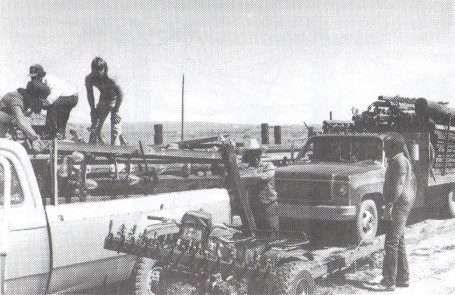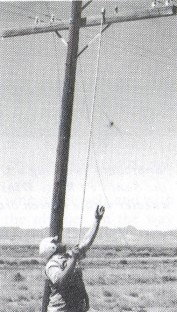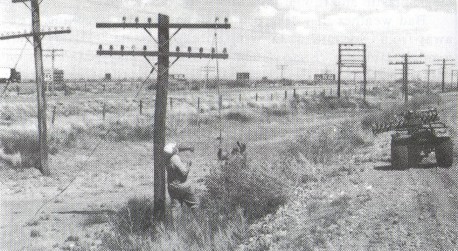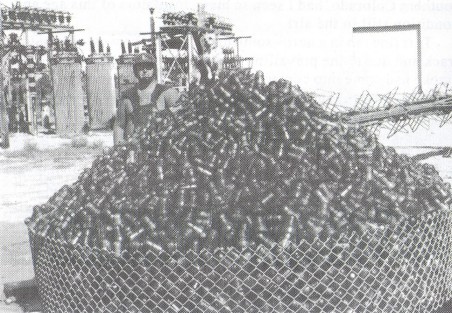The SANTA FE Trip of ’86
by Tommy Bolack
Reprinted from "Crown Jewels of the Wire", April 1996, page 16
In 1986 the Santa Fe Railroad contracted removal of a telegraph line from Las
Vegas, New Mexico to Santa Fe, New Mexico, wherein I had dealt with the
contractor to collect the crossarms and insulators. The 5,000 crossarms from a
prior wrecked-out Gallup-Winslow, Arizona line along with these, would provide a
good supply of fence posts for many years to come. The common insulators were to
be stockpiled for a future museum display called “Aqua Mound”.
The Las Vegas to Lamy section of the Santa Fe line was double arm and loaded
with CD 145’s, CD 152’s, CD 154’s and clear types. This line, second
oldest in the State of New Mexico, was the original mainline through Glorietta
Pass, built around 1879. Although I had never collected from that line, 20 years
have gone by since I had seen numerous CD 126’s, which have since disappeared.
They have apparently been collected as many clear, plastic and rubber now adorn
the crossarms.

Loading crossarms from the Gallup to Sante Fe line on the truck.
Bad weather in weeks prior had forced the wrecking crew away from Glorietta
to removing wire from Santa Fe-Lamy Spur, a single arm line. I had remembered
seeing many CD 126’s on that line also in the 1960’s near the Santa Fe area.
Owing to the lack of a roadway and rough terrain, I had decided not to collect
crossarms (6 pin) on this section but cleared with the contractor, allowing me
to pick off any glass I wanted. As they planned felling these poles with chain
saws, I felt I had better try to retrieve any good glass while the poles were
still standing.

In the early 1980’s, I had devised a special stick by which I could spin
off insulators from the ground providing the wire had been removed. (Tommy,
pictured above, waiting to catch a jade Am. Tel. & Tel. Co. toll snatched
from the Rattlesnake line south of Shiprock, NM.) It was adjustable for skirt
thickness and was successful in retrieving over 98% of those attempted. Of
course, climbers were always carried just in case a super rare jewel had extra
affection for its pin.
The nasty weather of previous weeks gave way to sunshine the last week of
December 1986 and loaded up with three-wheeler, snatcher stick, paper and boxes,
I headed out at 5:30 a.m. to Santa Fe with high hopes. The three hour ride gave
time to reflect on the disappointment of the Glorietta main line and lowered
expectations on what I may find today -- a handful of CD 126’s and a new piece
for the collection? Or nothing??
This December morning in Santa Fe found a breezy 15 degrees and four inches
of snow with sunny and crystal clear skies. Dressed for the Arctic, I headed
south from Santa Fe upon the “Big Red” Honda. This railroad line remained
well hidden in the Pinon-Juniper growth with only an occasional trail
paralleling or roadway crossing it. The three-wheeler was perfect as the snow
and terrain would have left only foot or horse travel as an option. At times,
the track itself was the path. However, with few trains using this spur, I felt
comfortable using it when needed.

"Snatchers" working a stubborn CD 145 H.G.Co. Petticoat from
the Santa Fe RR to Winslow, AZ line. "Big Red" Honda
three-wheeler with a barren crossarm on board awaits the snatchings.
Traveling south for three miles revealed nothing but 42’s, spirals, clear
glass and plastic. It was becoming apparent that my expectations were to be
realized even though I was enjoying some beautiful country. Even the new snow,
in its beauty, dashed hopes of finding anything upon the ground.
Mile 4 went by and still no luck — WHAT — up ahead nearly 5 poles, there
“shined” the shape and color of a CD 126 as clean as the day it was formed
over 100 years ago. The early morning sun glistened unusually bright and the
rescued piece revealed the cracks that made that piece shine so brightly.
Another mile down line found no more as the terrain became more difficult, not
to mention the increasing wind and clouds beginning to roll in. With snow in the
forecast, it seemed I was going for a dry run.
Murphy’s Law works both ways! As I was about to call off the search, up
ahead shined not 1 or 2, but 5 - CD 126’s on one pole! Needless to say, these
mint “teasers” picked up hopes immediately as I had apparently found where
previous collectors had “left off”. From then on the CD 126, CD 126.4 and CD
127 came up at times in groups of 4 or 5 and somehow I lost my concern for the
threatening weather as my attention became undivided. Never since 1967, with the
removal of the Narrow Gauge Railroad in southern Colorado, had I seen so many
insulators of this age and condition still in the air!
This line ran in a north-south direction on the west side of the track and
due to the prevailing westerly winds, no coal or diesel smoke had come into
contact with these insulators, making them extremely shiny. The galvanized wire
had not even left any trace of oxidation upon them!
The good luck continued as it began snowing around 3:30 p.m.. However, I was
determined to search as much of that 20 mile line as possible. The wet glass
continued to glisten as beautifully as it did in the sunshine. As the weather
closed in, I was content to have run nearly two-thirds of the distance to a
point where finds had significantly diminished. The snow made it difficult to
locate my chase vehicle which was ahead at a crossing. The wind also reduced
visibility. Thankfully, connection was made just in time as being overloaded
with glass, wet boxes were quickly giving out!
Cold, tired and wet I packed myself with the jewels and with stiff fingers
looked over and counted the plunder on the way home which, because of the
weather, took five hours. The yield: 250-CD 126’s; 35-CD 126.4’s one of
which was a light electric blue; 25-CD 127’s; and a CD 151 ice with purple
wisps. Both the blue and 151 were additions to the collection. It was so cold I
had not even noticed the purple wisps until the ride home! That five hour trip
sure did not seem that long as I sorted the jewels and checked embossings.
Arriving home around 10:00 p.m. ended a most enjoyable day although it did
not seem that long until the next day with sore neck and legs. The window to
gather had closed for awhile as that storm dumped over 12 inches of snow on the
area. One gets a feeling of touching the past as this line was the communication
thread to New Mexico for over 80 years. Somehow the thrill of finding any 100+
year old piece here would compare with unearthing threadless in the east. For
the most part, the “snatcher” is retired - I will certainly miss the old
lines however the memories of enjoyable times remain.
We certainly have a unique hobby - as fun and enjoyment may be had over
finding a $5 or a $5,000 piece. Rewards do not always come quickly but come to
those who keep on trying. Best of luck and good collecting.

Tommy Bolack in his insulator gladiator garb stands next to a newly
built "Aqua Mound". The mound is about 14 feet in diameter and over 6
feet in height. It is all insulators. Tommy suggests that he should sell chances
to guess how many are in the mound--the winner gets one hour to dig through the
pile (without breaking any) to find the cobalt EC&M buried within. Or, maybe
he should sell the insulators at 10¢ each and who ever sees the EC&M first
gets it for a dime! Atop the pile is "Renee" a protective friend who
goes everywhere with Tommy as he rides his Honda three wheeler.
| 